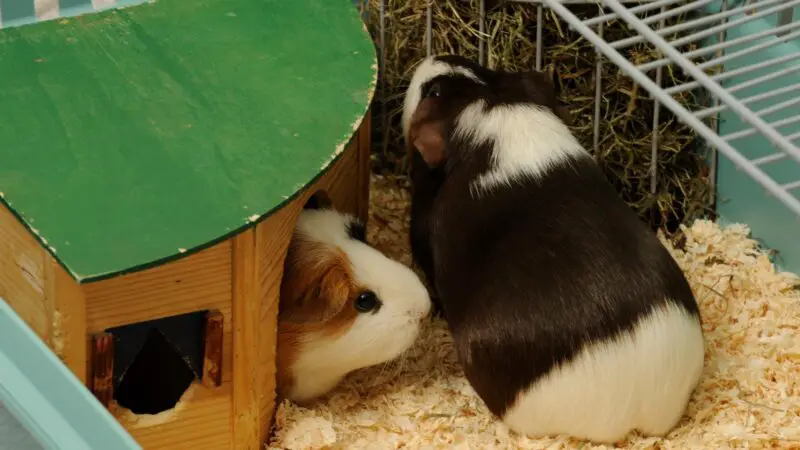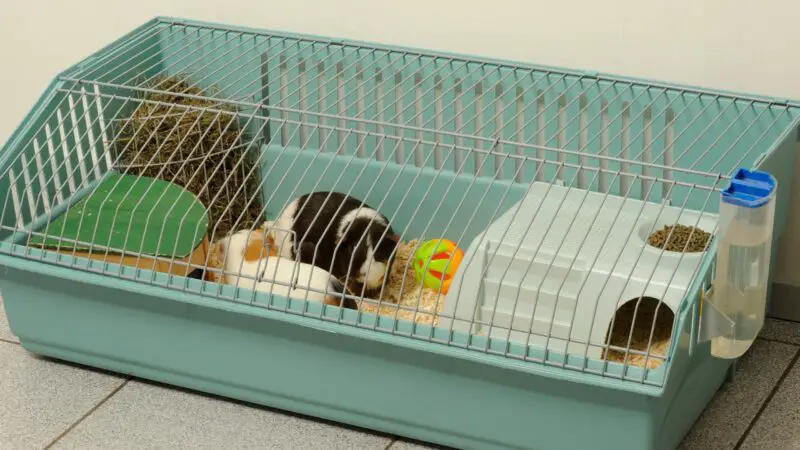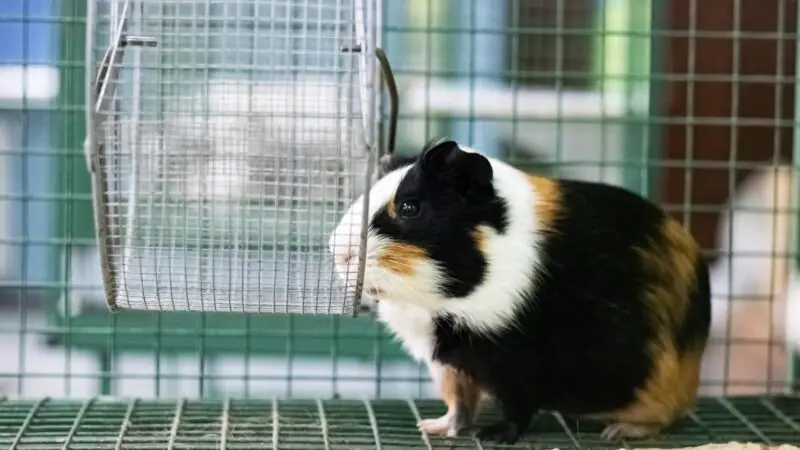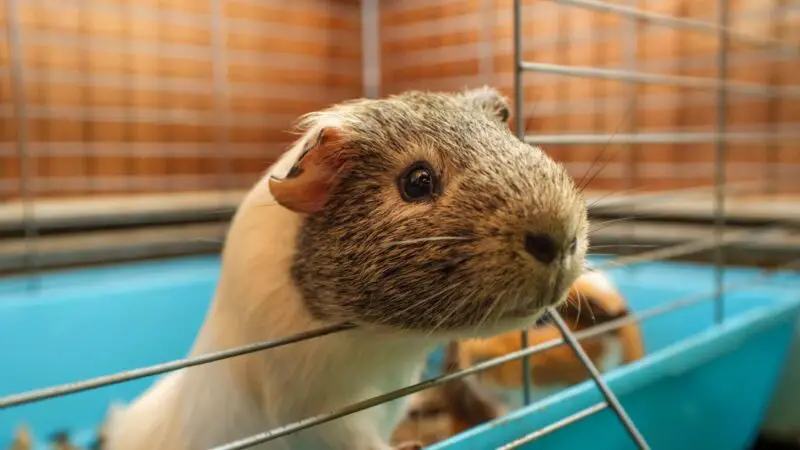You have just welcomed your guinea pig home and you are excited to start your journey together but you suddenly realized that you don’t know the most basic skills; cleaning a guinea pig’s cage. You probably started to wonder how often you should change the litter, scrub the cage and wash the toys.
The whole guinea pig cage cleaning process involves separating your guinea pigs from the cage, discarding the uneaten or old food, cleaning the cage, and then rebuilding the guinea pig’s habitat once again. Make weekly and daily cleaning tasks to ensure the cleanliness of its cage.
Table of Content
What Tools Can Be Used to Clean the Cage?

We will start off with basic supplies that are important in keeping your pet’s cage neat and clean. This can be already found in your house.
- Dustpan
- Brush
- Rubbish bag
- Vacuum cleaner
- Spray bottle with a vinegar-water solution
- Fresh bedding
- Paper towels
- Bin
We are a bit wary when it comes to commercial and standard cleaning products. Even if branded safe, they could still contain chemicals that are harmful to your guinea pig. For this reason, we recommend a mixture of water and white vinegar to efficiently and naturally clean your guinea pig’s space. But discuss this with your veterinary first if you have any doubts.
How Often Should the Cage Be Cleaned?

Cleaning should be done on a daily and weekly basis. There are certain activities or aspects of the cage that require daily replacement, while others weekly.
Daily tasks include:
- Removal of uneaten and old food (this avoids mold)
- Emptying and filling up water supplies
- Cleaning with hot water the food bowl and water bottle
- Spot cleaning the cage
- Remove droppings and any spoiled bedding
- Place fresh hay in the rack
Weekly tasks, on the other hand, are:
- Cleaning the whole cage
- Replacing the bedding
- Inspecting the toys to see if they need washing or replacing
- Rinsing the wire cage top and plastic trays, all with hot water
- Washing and scrubbing bedding and toys with a brush
It is equally important to focus on both weekly and daily cleaning tasks to ensure that your pet not only is in good health but happy and eating. By exposing your guinea pig to excessive filth or unsatisfactory amounts of food and water, you are risking vitamin C deficiency, possible scurvy outbreaks, and other symptoms of poor health. It is therefore vital to keep the hygiene standards very high.
Related: Guinea Pig Vitamin C Food List (Dosage, Serving Size & More)
How to Clean a Guinea Pig’s Cage? | Step-by-Step Guide

Step 1: Remove Your Guinea Pig From the Cage and Place It Somewhere Safe
Please do not leave them roaming around on the ground as guinea pigs tend to get into trouble by wandering off and exploring their surroundings. Therefore, place your pet in a box with an open top in a quiet area of the house because any loud noises can scare them. The last thing we would want is an injured or traumatized pet.
Step 2: Empty the Cage
Remove all the items that are inside the guinea pig’s cage. This includes any toys, bedding, furniture, water bottles, and food bowls. If there is any old food or water, we recommend that you empty their contents and replace them with fresher water and food.
Step 3: Check the Items That Need Replacement
Once you have pulled out all the contents in the cage, inspect them. Are the toys clean or dirty? Do they need to be washed? Are they intact or overly chewed? In this case, you might want to consider replacing them with new toys.
Step 4: Clean the Bedding in the Cage
Use a dustpan to scoop out any dirt on the bedding. Place it in a rubbish bag and make sure to throw it away immediately in a dustbin.
Step 5: Dust off the Cage
By using a brush or whisk broom, dig out smaller debris or dirt. Otherwise, we also recommend using the vacuum cleaner to clean out the bottom of your pet’s cage. This is important as any filth that remains can potentially cause health troubles in the future like respiratory issues.
Step 6: Disinfect
Mix together white vinegar and water, a 50/50 ratio, and use it to spray the sides and bottom of the cage. Leave it for around 30 seconds and then wipe dry. Repeat until the surface is completely clean.
Step 7: Deal With Stains
If you are having trouble with harder stains, leave on pure white vinegar for 5-10 minutes, and then proceed to wipe it off. An alternative can be a mix of baking soda and vinegar. Mixed enough to look like a paste, and then applied and left for 5 minutes. After which, you can wipe it off.
Step 8: Clean the Accessories
Whilst you are waiting for your vinegar mixes to work, focus on the smaller objects that you took out from the cage. Empty and clean out plastic trays, bottles, and bowls and wash them with warm water. Check also if any toys need extra washing.
Step 9: Place the Clean Bedding and Accessories Back in the Cage
Gradually fill in the cage again with clean bedding, toys, and accessories like bowls and bottles with fresh food. Then, place the newspaper underneath the bedding or chipping.
Related: Top 10 Best Guinea Pig Cages in 2022: Reviews and Guide
Step 10. Return Your Guinea Pig Back to Its Clean Cage
Go grab your guinea pigs and place them in their home again. Let them inspect their fresh and clean surroundings. Also, give yourself a pat on the back for a good job!
Pro tip: Sometimes vinegar and water solution can leave an unpleasant smell for both you and your guinea pig. Take a small drop or two of rubbing alcohol, leave it to dry and everything is back to normal!
Frequently Asked Questions About Guinea Pig’s Cages

What Is the Average Cleaning Time of a Guinea Pig Cage?
Overall, the average it takes a person to clean a guinea pig cage varies. When it comes to a deep clean, 40-50 minutes is the norm. Daily spot cleaning, on the other hand, takes no less than 20 minutes. Please note that the times may vary based on the type of cage and how many guinea pigs you own!
Do Guinea Pigs Need Bedding in Their Cage?
Guinea pigs need bedding in their cage. They also need comfort when they sleep, eat and play. Use carpeting or soft materials as bedding for your pet and give them an extra comfort. Please avoid using the newspaper as it is uncomfortable but do use it under the bedding for extra absorption.
Are Toys Necessary in the Cage?
It is important to note that guinea pigs are very active creatures and require constant monitoring or stimulation. Otherwise, boredom can set in, with devastating consequences.
Furthermore, toys help with movement and exercise. There is a stereotype surrounding guinea pigs and running often in their wheel, but it’s actually a myth. More importantly, such a toy can actually put the pet’s life in danger and injure its back.
Guinea pigs are delicate and a toy wheel can actually harm them. Toys like a pet tunnel and chew treats are, for example, ideal for your pet. These toys not only promote physical activity and stress relief but also ensure cleaner and healthier teeth.
Related: Best Guinea Pig Toys: A Helpful Guide
Which Guinea Pig Cage Is the Best?
There are factors that make a guinea pig cage great: size, dependability, easy to clean, weight, and built quality. Guinea pigs thrive in large spaces. Thus, between 100 to 130 cm in length and 50 to 65 cm in width is suitable for one guinea pig. Height is not as important and can range from 40 cm to 60 cm.
Expansion, which includes extensions, is important if you have more than one guinea pig. When you have one or more guinea pigs it is important that their little home be easily accessible and cleanable. This is where the weight of the cage is important in terms of transportability.
Lastly, quality also matters in terms of materials used for making the cage. A good quality cage does not break suddenly, rust, or risk cutting your guinea pig or yourself. Make sure the cage is made of polycarbonate and metal.
